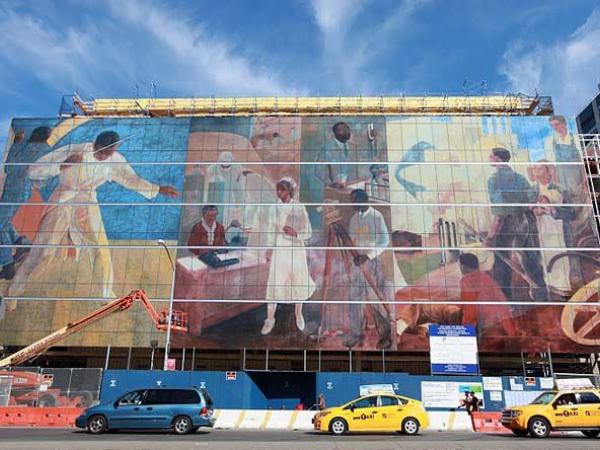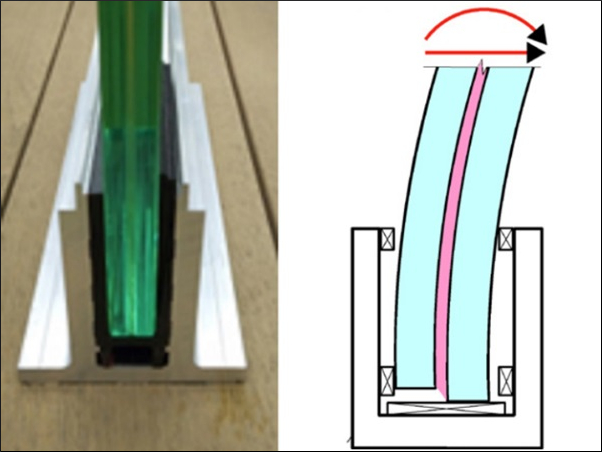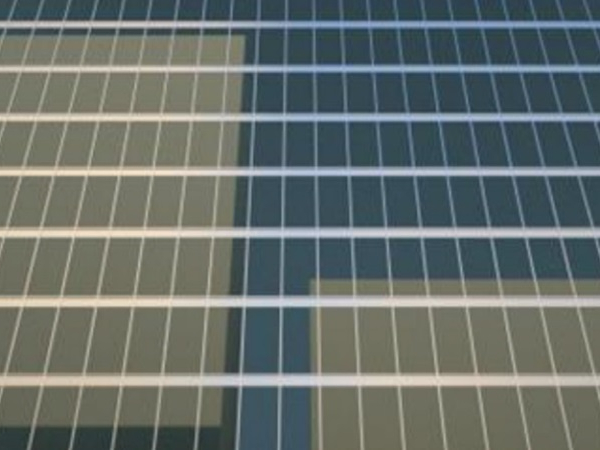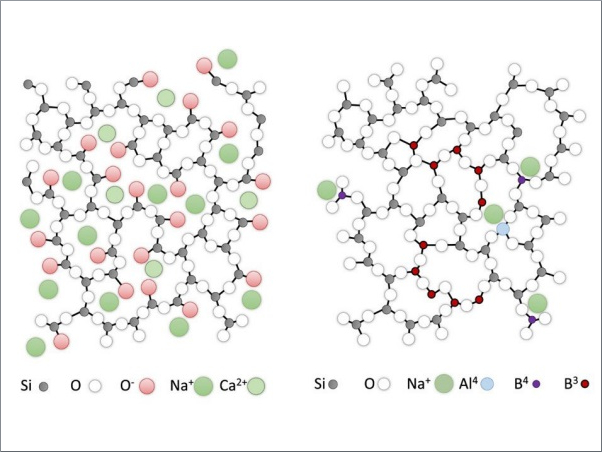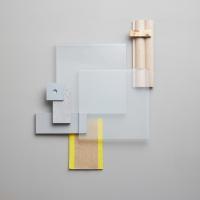This way even multicoloured very large format images and ornaments can be reproduced on glass by reflective high resolution prints, turning the functional glass skin of a building even into a more or less translucent artistic screen.
This way even multicoloured very large format images and decors can be printed and fired on glass providing reflective high resolution prints, turning the functional glass skin of a building into a more or less translucent artistic screen. After a short introduction into the basic principles of the Ceramic Digital Printing technologie and the world of Glass Façade Design the presentation will give an overview about the advantages and limitations of the Ceramic Digital Printing for architectural applications. Different design intentions, challenges and achievements will be presented and discussed. TOPAZ - a helpful concept of preceding considerations for the design process of glass facades will be introduced.
1.Ceramic Digital Printing
Figure 1 : Ceramic Digital Printing : Harlem Hospital, NYC [3]
1.1. Ceramic Printing
The demand for a longlasting quality for printings on architectural glass is strongly restricting the use of organic materials in combination with in-organic, mineralic glass. In the last century Silkscreen Printing has become the major technique for the graphical application of ceramic inks on glass. There have been many developments in the Silkscreen Printing technology trying to enhance the quality and to reduce the efforts. Even here the (organic) Digital Printing has entered the process, helping to avoid films and the photographic stencil development on screens using CtS (computer-to-screen). The Silkscreen Printing is an analog process still, even though many professionals may often wrongly talk about a "Digital Silkscreen Fritting" when they are actually looking for a "Ceramic Digital Printing".
1.2. Digital Printing
Since the introduction of the applicable computer to the world in the 60´s of the last century, most social and industrial processes have undergone revolutionary changes. The quality, quantity and resolution of data processing has at least doubled in every decade. So nowadays the digital processing has passed the challenges of it´s analogancestors in almost every working field. Even the limits of photografic image reproduction have yielded to the quality of modern digital printing.
.jpg)
Click to enlarge UserFiles/tab1(8).jpg
.jpg)
Figure 2: HiRes-Ceramic Digital Printing-6-color-print [1]
1.3. XXL-Printing
According to the use of modern graphic programs, data processing and storage the world of large format design has opened not only for highly sophisticated professionals. Every image can now be processed and reproduced in high qualities in gigantic formats.

Figure 3 : White CDP with colour-illumination, Rockheim , Norway [3]
Table 2 is showing the amount of graphical data that can be processed by modern data storage devices, to give a feeling for the amount of graphical information needed.
.jpg)
Click to enlarge UserFiles/tab2(12).jpg
Here we can see, that the amount of information for a high resolution image print might be important for a smooth data-processing. One of the greatest challenges of a professional Facade Glass Design preparation is it, to determinate the best composition of vector- and bitmap-information according to the most important distances and effects.

Figure 4 a,b,c: CDP-detail seen from 30 m , 3 m , 30 cm distance , "One Reading Central", UK
1.4. Ceramic Digital Printing
The Ceramic Digital Printing (CDP) can be seen as a synergy of the advantages of the Ceramic Silkscreen Printing (CSSP) and the Digital Printing with organic inks (solvent, watersoluble, UV-cured, etc.). For a successful development of the Ceramic Digital Printing on glass two main issues had to be mastered: A new system of colour-pigments with particle diameters less then some 1/100th of the
conventional sizes, performing with reliable results in the temperature range of flat glass tempering (550-750°C) and sufficient mixing properties had to be found and established.

Figure 5: REM-images of CSSP and CDP pigments [3]
And even more challenging, the erosive character of ceramic pigments that are usually grinding on the delicate architecture of multi-nozzled printheads, eating them up step by step within an unpredictable period of time, had to be tamed.
.jpg)
Click to enlarge UserFiles/tab3(6).jpg
2. GlassJet
This issues of particle size and erosion have been solved, leading to the production of a Ceramic Digital Printing system named "GlassJet" which has been introduced to public during the Glasstec 2004 in Düsseldorf. This standard industrial printing solution is capabel of printing 6 colours of ceramic pigments on flat glass directly, allowing a resolution of more then 360 dpi, using a drop-on-demand technology on areas of 2800 x 3700 mm and even 3300 x 6000 mm in a single pass.

Figure 6: Ceramic Digital Printing system GlassJet PRO 24 [3]
2.1. Colourful Hi-Resolution
A high quality colourful fotorealistic reproduction can be achieved. Due to the low viscosity of the inks on glass a resolution of 360 dpi in most cases will be the best setting for most spectacular results. Every single point of an artwork can be coloured and controlled individually, granting the highest quality in positioning and registration (very important for multi-coloured prints). Within one print the density of each part can be defined from highly translucent to solid, controlling the amount of ink preferred.

Figure 7: Worldmap , opaque colours with transparent blue
2.2. Optical properties of GlassJet inks
The GlassJet inks are mostly reflective to garantee a bright colour reflection. Only the blue ink is of transparent nature to allow a nice reproduction of water and air qualities. It can be made reflective by adding other more reflective inks (white).
2.3. Certifications
Performance reliability and qualities are comparabel to the common industrial standards of the professional Digital Printing. Thus digitally printed safety glass products have aquired most of the certifications needed for their architectural outdoor application. Their applicability monolithic or inside of laminated glass and/or in combination with solar-control coatings is proofen.
2.4. Results
The range of chances for creating new artwork or reproducing design solutions on architectural glass is tremendous. Here you can find a selection of some designs that have been developed:

Figures 8 a, b and c: Imitations of Streakmetal ; Glassbricks ; PV-Elements [1]
Material Imitations
Optical imitations of fabrics, streakmetal, metal surfaces, carbon fibre, stone, marble, plants, clouds, streaks, drops, glassbricks and other natural or technical objects and effects have been produced with Ceramic Digital Printing on glass successfully and built into facades and rooftops:

Figure 9 : Marble imitations with CDP , Ave. Friedland, Paris [4]

Figures 10 a, b, c : Brisbane towers micro-blinds; Stones; Etch-imitation, French consulate London

Figures 11 a, b, c: Wood-imitations and PV-cell-imitations
3. Conclusions
The Ceramic Digital Printing on glass can substitute most of the known techniques of glass decoration up to a very high extend. Most of the effects that can be attained can be combined with one another simultaneously in just one step of production. Technical and decorative effects for new individual indoor and outdoor design solutions can be generated that have been impossible before. For architectural applications biggest advantage of the CDP will probably be the multicoloured XXL-format production, where one image can be tiled and distributed to various tiles so that every panel can own its own design without pushing the costs and efforts of production skyhigh. A further advantage of the CDP is the opportunity of shortening the time necessary for a glass design development process by providing different variations of CDP-samples within very short periods of time. The production time (the print, drying and firing) of one small sample can be reduced to be less then one hour if everything has been prepared nicely.
4. Glass Design Engineering
The Ceramic Digital Printing is not just a technique of reproduction but can be used as a totally new technique providing effects and artwork solutions which have formerly been impossible. With CDP the faculty of Glass Facade Design is no longer restricted to standard sheet materials and standard design patterns like monochrome silkscreen rasters, for example. Sophisticated colourful graphical compositions can now be calibrated exactly according to architectural intents.

Figure 12 a, b : 6-color silkscreen imitation by CDP, Bundesministerium BMF, Berlin (the top-down-gradation, staircases and the green tree are part of the printed artwork)
This advanced processes of creating most suitable skins for a building are no longer just about picking an artwork and ordering some print-versions on glass, but they are bearing the chance and challenge to optimize the design individually. This optimizations are depending on combinations of design parameters that often have not been relevant to be taken into consideration before. Sometimes those parameters even seem to possess uncertain definitions. Therefore we are presenting a checklist for glass design projects that will help to consider those parameters to round-up a project definition and may provide useful conventions for a plain design language:
5. T O P A Z a checklist for facade glass design projects
5.1. TILING
The first step will be the determination of the maximum panel format to provide the chance for a smooth workflow without exceptions.
5.2. OPACITY
The lightflow is the major difference between "Glass Design" and "Paper Design". Paper Design is based on light-reflection mainly, whereas Glass Design is handling 3 different important main characteristics of lightflow:
Reflection (REF) - Transmission (TRM) - Absorption (ABS)
Reflection:
Shadow box applications will be printed opaque or even solid to avoid the background to shine through. Those are working almost completely on reflection. Most of the inks of the GlassJet are of reflective nature to be compatible for outer facade design, avoiding the "church-window-effect", the fact, that transparent colours are great for projecting transmitting light but tend to "fall into grey" being seen in reflection.
.jpg)
Figures 13 a, b : The Church-Window-Effect: Cathedral-windows in transmission & in reflection
Transmission:
Most facade applications will use the wide range of light-transmission.
Functional and aesthetical aspects will determine the transmission wanted. These effects can be determined qualitatively by defining the scattering of the light and quantitatively by calculating the lightflow within the visual spectrum.
![]()
Click to enlarge UserFiles/tab4(8).jpg
Absorption:
The absorption will be important for the energy flow during the production process and for the energetic ecology of the mounted panel (IGU) and its environment.
.jpg)
Figures 14 a, b : CDP in transmission (daylight) & in reflection (black background)
5.3. POSITIONING
A design printed on transparent substrates can often be seen from both sides. Even if inks are printed simultaneously there will always be more or less significant differences in the performance of surfaces printed with different sequences. Therefore it might be important to determine, which sides will be most important. For translucent or transparent panels it will be essential to consider the positionings of the light and of the viewer to get an idea about the resulting design effects.
5.4. ACTIVE WHITE
Opaque prints on glass are using the color White to print light-reflections. On paper prints those will be left unprinted. On glass, White can be functioning as a substitute for the usual paper background. Translucent prints might need the colour White to show light in reflection, but they usually will not be specified in the artworks automatically. In most cases it will be necessary to discuss the use of the White on glass in advance.
5.5. ZOOM
For large architectural artworks it often is very important to chose an interesting graphic strategy for the transfer of the relatively small basic image bitmaps into large facade cladding prints, especially if people will have to live with it closely.
.jpg)
Figure 15 a, b : Photoshop-file and printed glass panel with recomposed design
A more practical version of the TOPAZ checklist can be found on CERDIP.COM

Figure 16 : CDP-printed facade , "One Reading Central" [4]
6. Summary
The technology of the Ceramic Digital Printing is providing an instrumentation that has proofen itself to be a real advantage in the field of designing and producing architectural flat glass, inspiring professionals to create new visions and solutions for future projects. The Ceramic Digital Printing is not just a machine of standard image reproduction, butan instrument of versatile approaches and effects, that might help to create really progressive individual design solutions, helping to add more character to the functional glass skins of modern architecture.
7. Facade Glass Design Service
Many developments have been made according to the new advantages and challenges of the CDP and the design and production process surrounding it. New designs and technologies are demanding proper tools, experience and sometimes even new hard- and software solutions to be developed and applied successfully. A combined Facade Design Consulting, Facade Design Glass Production, Prepress and Production Service will be helpful to optimize a creative and productive workflow.
8. Design Software Solutions
Design software solutions like Bitmap-Analyzers, Bitmap-Modulators and Bitmap-Synthesizers are helping to optimize the composition of colours. (B2B-software) Even more interesting for the XXL-format imaging will be Bitmap-to-Vector modulators and synthesizers that are able to modulate or generate graphical structures by the use of vector objects according to mathematical algorithms (B2V-software). This tools will help to provide a wider spectrum of alternatives for the production of new designs.

Figure 17: Analysing printed contrasts with CERDIP-software [1]

Figure 18: Analysing colourspace-distributions with CERDIP-software [1]
References:
All texts, pictures and tables by Hoffmann GTD unless stated differently.
- Hoffmann GTD
- Cerdip.com
- Dip-Tech.com
- Interpane.com (Ipadecor K)
Acknowledgements:
- Hoffmann GTD, Germany
- DipTech, Israel
- Interpane-Sicherheitsglas, Germany
AUTHOR: Dipl.-Ing. Bernd Hoffmann, glass design engineer - Hoffmann GTD Glas-Technik-Design, Germany, GTD@gmx.com, CERDIP.com


